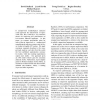Free Online Productivity Tools
i2Speak
i2Symbol
i2OCR
iTex2Img
iWeb2Print
iWeb2Shot
i2Type
iPdf2Split
iPdf2Merge
i2Bopomofo
i2Arabic
i2Style
i2Image
i2PDF
iLatex2Rtf
Sci2ools
ACL
2012
2012
Unsupervised Morphology Rivals Supervised Morphology for Arabic MT
If unsupervised morphological analyzers could approach the effectiveness of supervised ones, they would be a very attractive choice for improving MT performance on low-resource inflected languages. In this paper, we compare performance gains for state-of-the-art supervised vs. unsupervised morphological analyzers, using a state-of-theart Arabic-to-English MT system. We apply maximum marginal decoding to the unsupervised analyzer, and show that this yields the best published segmentation accuracy for Arabic, while also making segmentation output more stable. Our approach gives an 18% relative BLEU gain for Levantine dialectal Arabic. Furthermore, it gives higher gains for Modern Standard Arabic (MSA), as measured on NIST MT-08, than does MADA (Habash and Rambow, 2005), a leading supervised MSA segmenter.
| Added | 29 Sep 2012 |
| Updated | 29 Sep 2012 |
| Type | Journal |
| Year | 2012 |
| Where | ACL |
| Authors | David Stallard, Jacob Devlin, Michael Kayser, Yoong Keok Lee, Regina Barzilay |
Comments (0)

